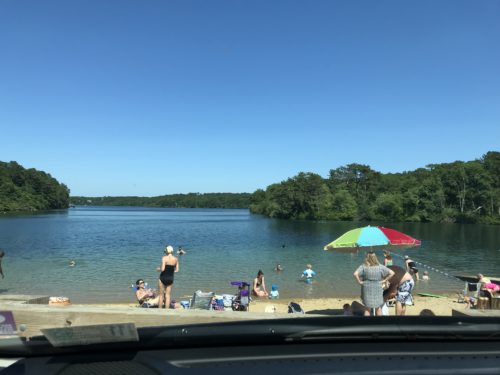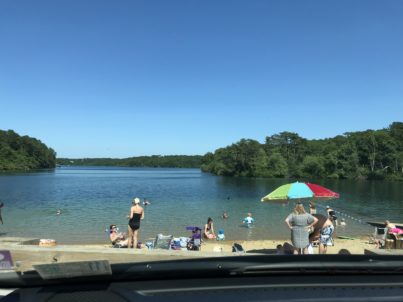Brook – a small, natural stream of fresh water
Creek – (in the U.S., Canada, and Australia.) a stream smaller than a river
Stream – a body of water flowing in a channel or watercourse, as a river, rivulet, or brook
River – a natural stream of water of fairly large size flowing in a definite course or channel or series of diverging and converging channels
So a brook is smaller than a creek which is smaller than a steam which is smaller than a river.
Difference between lake and pond

The major distinguishing factor between lakes and ponds is their depth. Deeper bodies of water create different, more complex environments for aquatic life than shallow ones.
We will probably never have a system of precise definitions for lakes, ponds, and wetlands. Experts, called Liminologists focus on the differences between deep bodies of standing water and shallow ones.
Also:
A BOG is a wetland that’s acidic; a FEN is a wetland that’s alkaline; a SWAMP is a wetland that’s vegetation consisting of trees or other woody plants; and a MARSH is a wetland with other forms of vegetation.
Limnology is the study of inland waters. Limnologists divide surface waters like lakes, ponds, and rivers into two broad categories: lotic waters, which flow in a continuous, definite, identifiable direction; and lentic waters, which do not. Lentic waters may start as mere puddles, but can grow to become lakes, ponds, or wetlands. This growth occurs so slowly that it is difficult to define the transition from one type of lentic water to another.
A deep lake or pond is surrounded by a shallow shoreline region capable of supporting rooted plant growth (if the soil allows) and representing a distinct biological zone. Its floor descends to produce an area deep enough to prevent sunlight from reaching all the way to the bottom. In temperate climates, the large swings in ambient temperature produce distinct thermal layers, especially in warmer months.
From Pond Academy: A shallow lake or pond allows sunlight to penetrate to the entire floor, allowing for rooted plant growth throughout the entire body of water (soil and other factors notwithstanding). Shallow bodies of water tend not to create thermal strata, however much their environments may change with the seasons, and support significantly different ranges of aquatic life than deep bodies.
Layman’s terms
What is a Lake?
Lakes are deep. At their deepest points, they do not allow sunlight to reach their floors. Neither algae nor phytoplankton can live in these sunless zones, which makes for a distinctive ecosystem populated exclusively by carnivorous organisms. In temperate zones, lakes feature two or three thermal strata during summertime months.
What is a Pond?
Ponds are shallow. Sunlight penetrates to their floors at all points, supporting a more consistent ecosystem than do lakes, including rooted plants and pond weeds, algae, and phytoplankton. Regardless of the surrounding climate, they feature only one thermal zone, though the character of that zone may change with the seasons.
*Kettle Ponds
Cape Cod in Massachusetts has kettle ponds scattered throughout the peninsula at Wellfleet, Truro, Brewster, Harwich, and Eastham. These unique kettles were formed as a product of the Ice Age some 15,000 years ago. As the glacier ice melted, it left behind massive holes or “kettles” that later filled with fresh water. Those kettle holes with a layer of clay beneath them collected water early on, filling up. Others only evolved into ponds when the freshwater table rose and the bottoms of the kettles intersected the rising water level.
While many kettle ponds provide a freshwater alternative to the beach, salt ponds are also kettle ponds if they are connected directly to ocean waters. Some of the deeper freshwater ponds that are connected by active creeks or brooks to saltwater often serve as the final destination for herring runs. During the spring, thousands of these alewife fight uphill to their place of origin to lay their eggs and renew the cycle.
Scientists find the kettle ponds fascinating as pollen and the remains of living organisms trapped on the bottom layer of the ponds serve as a historic record of earlier climate patterns. Ponds are critical to many of the local communities as well as an overall barometer of the quality and purity of the drinking water.
